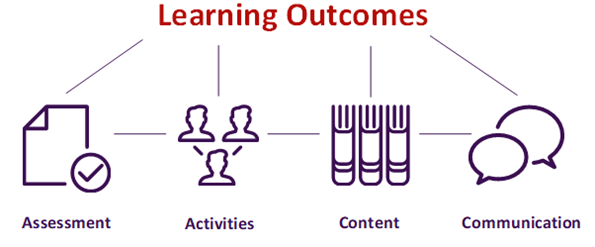Overview
- Blended learning encourages use of active, student focused approaches.
- These approaches can increase the depth of learning and engagement.
- Planning blended units requires the total reconceptualization of a unit.
- Constructive alignment is the key guiding concept.
- Avoid simply ‘adding on’ online elements as this often leads to content overload.
On this page
Constructive alignment
New units vs reconceptualising an existing unit
Resources for unit planning and alignment
Choosing the right blend
Constructive alignment
No matter whether your unit is new or a course re-design, alignment between learning outcomes, assessment, activities, communication strategies and content is essential.

For further reading on constructive alignment, see Mapping learning across the curriculum.
New units versus reconceptualising an existing unit
Using a blended approach allows you to reimagine your course. When you design a unit from scratch you have a blank canvas to start from, without any presuppositions of how a unit should be structured.
When you are re-designing a course, it is best to try and adopt the same mindset of ‘beginner’s mind’. Try to consciously loosen the closeness you have with the previous unit, dropping your preconceptions of how the unit has run and start from the course objectives afresh.
There are some common pitfalls to be aware of. These are –
- It is important to not just “add on online components” to an existing course, as this can lead to too much content and unreasonable workload for students and teachers.
- It may be tempting to translate aspects from the original course directly into the new course, but direct translation might not be the best strategy. You will need to consider timing, the skills of teachers and whether learners are being adequately prepared.
- Selecting technologies should be driven by educational imperatives, not the other way around.
Inclusive blended learning design
Universal Design for Learning (UDL) is a framework to improve and optimize teaching and learning for all people based on scientific insights into how humans learn. At the core of UDL is the principle of inclusiveness and equity. UDL considers the diversity of abilities, disabilities, racial/ethnic/socio-economic backgrounds, reading abilities, ages, and other characteristics of the student cohort. UDL is founded on the idea that learners need to have equal access to learning, not simply equal access to information.
UDL is founded on three core principles: Engagement, Representation and Action & Expression (CAST, 2022). These three principles can be applied to the planning and delivery of courses, and the assessment of learning, to facilitate inclusive attributes that embrace diversity whilst maintaining academic standards. UDL also aligns with constructivist claims that teaching and learning activities that tie down the learning to multiple sensory modes create interconnected knowledge that restructures understanding and supports deep learning (Biggs and Tang 2011).
The core principles should be taken into consideration when deciding on the blend of resources and use of technology. More information about UDL can be found by visiting ACU's Access and Disability Service. The CAST website provides extensive information on the implementation of UDL.


